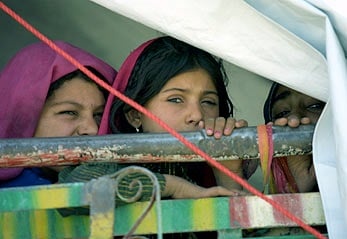Lesson plans for ages 12-14 in Art: Repatriation and Graphic Communication
Lesson plans for ages 12-14 in Art: Repatriation and Graphic Communication
-

Afghan refugee girls on a return convoy from Pakistan.
INTRODUCTION
The mandate of UNHCR is to look after refugees. However, it is not in the best interests of the refugees, nor that of their host country, for the refugees to remain indefinitely in the country of asylum. In seeking positive, lasting alternatives, UNHCR has three durable solutions: voluntary repatriation, local integration, and permanent resettlement. Voluntary repatriation is the most preferred solution.
There are times when the refugees are hesitant to return home because they fear danger still exists for them. This was one of the reasons why Rwandan refugees remained in camps in Zaire and Tanzania in 1995 and 1996 despite encouragement from UNHCR to go home, and despite Rwandan government assurances that they could return in safety. However, usually refugees want to go back to their own countries, to their own homes and dwell among their own people. When the original conflicts that drove the people out of their countries have calmed and the situation in the home country allows safe repatriation, the refugees do return, as in the case of Mozambique in 1994.
In this unit, the students are required to produce a sequence of simple drawings that could be used in a campaign designed to encourage refugees to repatriate.



